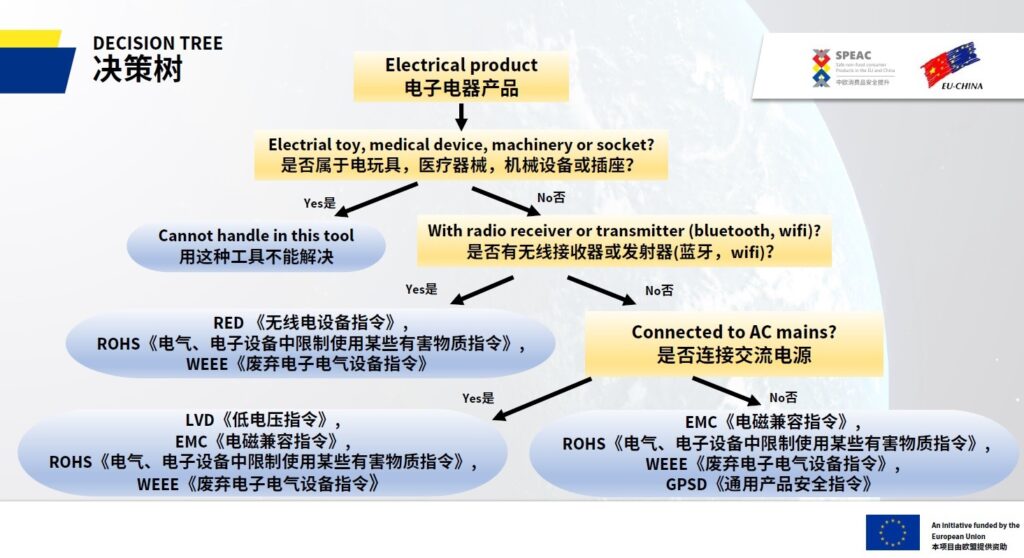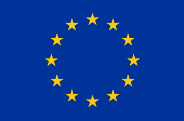
Safe non-food consumer Products in the EU and China
There are many different directives that may come into play for electrical products. The most common ones are:
A decision tree has been developed for electrical products to help manufactures identify the applicable legislation for individual cases. The idea is that you start from the top and work your way from box to box answering the questions with ‘Yes” or “No” and then you follow the route to the next box. At the bottom you will see which directives apply to your product.

Starting at the top of the decision tree, the first box says “electrical product” because this tree only works for electrical products.
If a product is electrical, the user moves to the second box. It says “Electrical toy, medical device, machinery or socket?” The tool cannot be used for these types of products, as you can see at the end of the arrow with “yes”.
If, however, the product is another kind of electrical product, the user then follows the arrow with the “no” to the next box that says, “With radio receiver or transmitter?” which includes transmission systems like GSM, Bluetooth and Wi-Fi. Radio communication does not include infrared communication as you will know it from many remote controls. Radio transmission only comprises technologies that use radio waves.
If the user has radio communication in your product, they follow the arrow with the “yes” that will take them to a list of directives.
If the user does not use radio transmission, then they follow the arrow with the “no” to the right to a box with the question “Connected to AC mains”.
Again, they need to answer the question and follow the arrow with “yes” or “no” depending upon their answer. A fully correct question would be “Is your product connected to a voltage between 50 and 1000 V AC or 75 and 1500 V DC” but in reality, products in this category are rarely seen other than those connected to AC mains.
Example – 230 V luminaire with an LED light source
It is an electrical product, so the tree can be used.
It is not an electrical toy, a medical device, a machine or a socket, so follow the arrow with “no” to the right.
It does not employ radio transmission, so again, follow the route with “no” to the right.
And finally, it is connected to AC mains so in the last box follow the arrow with the “yes” to the left.
This means that we end up with LVD, EMC, ROHS and WEEE that would apply to the luminaire.
It is important to remember that there are also eco-design and energy labelling requirements that need to be considered separately. There are more than 40 directives or regulations for eco-design and energy labelling, and some of them have very specific exemptions.
These areas do not fall within the scope of the SPEAC Academy, so if a product falls in to one of the categories below, it is important to examine the applicable legislation thoroughly to determine whether a product is in scope or not.
You can find further information on this subject at https://ec.europa.eu/info/energy-climate-change-environment/standards-tools-and-labels/products-labelling-rules-and-requirements/energy-label-and-ecodesign/energy-efficient-products_en
Standards
Most products on the market will be covered by one of these three families of standards:
These are referred to as families of standards because the standards are structured with a base standard – a part 1 – that describes all the common requirements. And then we have a number of specific standards – part 2 standards – that describe the specific requirements for different types of products.
Using luminaires as an example – the basic requirements are laid down in the standard EN 60598-1. In additional, you then have part 2 standards for fixed luminaires, recessed luminaires, portable luminaires, child-appealing luminaires, lighting chains, rope lights and many others.
A manufacturer of a luminaire will always have to use two standards: The base standard EN 60598-1 and the part 2 standard that applies to their type of luminaire.
There is a full overview of EN60598 at https://ec.europa.eu/docsroom/documents/43964
This situation is the same for electrical appliances. The base standard is EN 60335-1, and then there are more than 100 part 2 standards covering products such as electrical irons, shavers, grills. hair dryers, microwave ovens and electrical toothbrushes.
There is a full overview of EN 60335 at https://ec.europa.eu/docsroom/documents/46674
You can access the Low Voltage Directive at https://eur-lex.europa.eu/legal-content/EN/TXT/?uri=CELEX%3A32014L0035
You can access the Electromagnetic Compatibility Directive at https://eur-lex.europa.eu/legal-content/EN/TXT/?uri=CELEX%3A32014L0030
You can access the Radio Equipment Directive at https://eur-lex.europa.eu/legal-content/EN/TXT/?uri=CELEX%3A32014L0053
You can access the General Product Safety Directive at https://eur-lex.europa.eu/legal-content/EN/ALL/?uri=CELEX%3A32001L0095
You can access the Directive on Reduction of Hazardous Substances at https://eur-lex.europa.eu/legal-content/en/TXT/?uri=celex%3A32011L0065
You can access the Directive on Waste Electrical and Electronic Equipment at https://eur-lex.europa.eu/legal-content/en/TXT/?uri=celex%3A32012L0019

This website was created and maintained with the financial support of the European Union. Its contents are the sole responsibility of SPEAC project and do not necessarily reflect the views of the European Union.